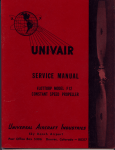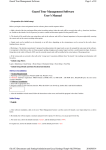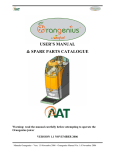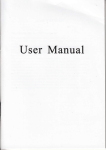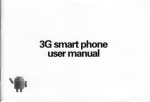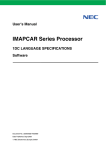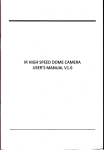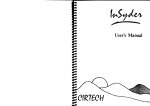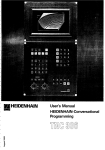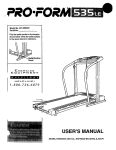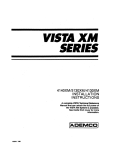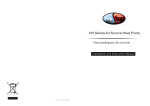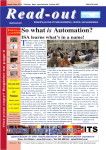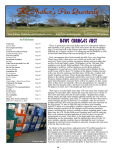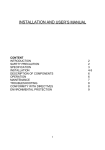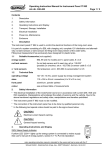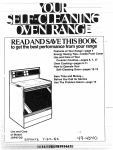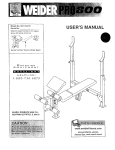Download user`s manual 6" planer jointer
Transcript
USER'S MANUAL 6" PLANER JOINTER JOINTER SHOWN WITH STEEL STAND AND ELECTRICAlS SAFETY RULES FOR ALL POWER TOOLS As With all electrical power tools it is important to read and follow the safety guidlenes in this instruction manual. By using the tool in the in the manner for which it is designed and by follo wing the safety precautions,it will considerably lessen the possibility oF p ersonaf injury BEFORE PLUGGING IN YOUR POWER TOOL 3 . Read the instruction manual fully and understand the applications and potential safety hazards Do not modify this tool without expert advice. 2. GROUND ALL TOOLS. If tooi is equipped with a 3 prong plug it shouid oniy be used with a 3 hole recepticle. if an adaptor is used for 2 prong recepticle, theadaptor lug must be attached to a known ground. 00 NOT REMOVE THE 3R'D PRONG. 3. SAFETY GUARDS. are there for your protection, ensure they are correctly fitted and in place. 4. ACCLDENTAL STARTING. Make sure switcn is "OFF" before pivgging in your tool. 5. ADJVSTlFrSG KEYS Make sure all keys and tools are clear ot work area. 6. KEEP WORK AREA CLEAN. Cluttered work area sare 3 potential safery hazard. 7. WORKING APPAREL. Make sure you have n o loose clothing such as tles. jeweiry that could get caught. DURING OPERATION - USE =ORRECT Make sure you are which it is using the 'Oo' in the manner designed. 2. FORCING YOUR TOOL. Do not force your tool it wiil operate correctly and give better resuits using normal pressure. 3.DON0 T OVERREACH. Keep a proper footing and baiance a l all times, 4.T00L MAINTAtNANCE. A sharp and 'lean wiil give you the best performance. Follow instructions far lubricating. 5.CHANGING ACCESSORIES. Make sure machine is switched "OFF" before chanoina - - accessories and make sure the accessories are desianed for vour twl in moving parts. An overall is recommended to be worn during operation with sturdy rubber footwear. 8. SAFETY GOGGLES. use an approved safety goggle or glasses to protect your ey8s.A dust mask should alsobe used during dusty operations. 9. SECURE WORD. Firmly secure work piece in a vice clamp or jig.Avoid getting your hands ciose to moving parts. 10. WORK AREA Keep your surrounding work area clean,dry and will illuminated. 11. KEEP CHLDREN AWAY. Before operation ensure children or visitors are kept at a safe distance. t2. TOOL LOCATION Whether a floor or bench model make sure your tool is on a leves surface and cannot more during operation. Berch models should be bolted down AFTER USE 1. DISCONINECT YOUR MACHINE so tha cleaning or rno sdon. 2. CLEAN YOUR MACHINE and working arrea and put all tools and accessories away out of the reach Of Children' 3. DAMAGED Before further use ensure you replace faulty or damaged parts. Using your tool without it being in perfect working order could proove hazardous 4 , SERVICING keep your tool lubricated and clean with all moving parts alligned and in good condlition 5. LOCK UP YOUR TOOL in an area where chiidren or visitors can not gain access, With Proper care and dmaintainance your power tool can give you years of dependable service. ADDITIONAL SAFETY RULES FOR JOINTERS $.KEEP cutterhead sharp and free of all rust and 4. ALWAYS make sure exposed cutterhead behind pitch. 2. ALWAYS use a push block when jointing stock that does not give a reasonable distance of safety for your hands. 3.NEVER pass hands directly over cutterhead. thefence is guarded,especially when jointing near the edge. 5. DO NOT perform jointing operations on material shorter than 8 ioches. narrower than 314inch,or less than 114inch thick 6. DO NOT periorm planing opmtions sh&y on materlal than 8 i ~ h e g , n than a ~ ~3/4imh, ~ wider than 4 Inches.or thinner than 112 inch. 7. MAINTAIN the proper relationship of infeedand wffeedAabre surfaces knife pgth8- SUPPORT the work piece adequately at all times during wration.maintain control of the work at all times. 9. DO NOT back the work toward the infeed taus. 10. DO NOT attempt to perform an abnormal or little used operation without study and the use of a d e q u a t e h o Id - d o w nlp u s h biocks,jigs, fixture.stops,etc. 11. DO NOT make cuts deeoer than 118" In a sinaie pa,,, On cuts more than " widedjust depth of cut to 1116 or less to avold overtoaing machlne and to minimize chance of kick back. - f4 - UNPACKING AND C l fAMlNG Carefully unpack the jointer, stand, and all loose Items from the cartons. Remove the protective coating from the machined surfaces of the 1oInter.This coating may be removed with a soft cloth moktrmed with kerosene (do not use acetone, gasoline or lacquer thinner for this purpose). After cleaning, cover all unpainted surfaces with a good quality paste wax. CHASSIS ASSEMBLY 1 I _ FIX the chassis according to the chassis assembly dtawing.(as shown in flgure two) ELECTRICITY PART ASSEMBLY Eleetrieaf machinery.switch and power source line are all fixad-an the chassis. First fix electrical machinery and power source on the chassis, and then join eleetrlcal machinery line to the switch line dots one and three and join power source line to the switch line dots line two and four.Afierthat, fix the switch to the side board.FIX erectricml machinery line and ground wire of eleetrlcal source as shown @I fig.A(surfaees are yellow and green) on the side board of the chassis, using the screw and screw nut.(as shown in figures Fig. 8 Aands) Fig.A ASSEMBLING JOINTER TO STAND 1. When assembling the jointer to the stand, the infwd and of the jointer is to be on the end of the stand indicated as (1) Fig. C.The three holes (3) are used for mounting the jointer to the stand. 2. Three hex head cap strews and lockwashers are 1 used to fasten the jointer to the stand. Place the three lockwashers on the three holes (3) Fig. C. In the stand and thread the screws In the three holes in the base of the jointer. Fig. c ASSEMBLING BELT ALlGNlNG PULLEYS AND ADJUSTING BELT TENSION Assemple the belt (3) to Ihe cutterhead pulley ane motor pulley.(l),as shown in Fig. D. if necessary loosen the nuts and bolts that fasten the motor to the motor plate and move the motor up or down on the motor plate until correct belt Zenslon obtained. Correct tension is obtainedwhen there approximately I" deflection in the center span the belt using light finger puessure. Using stralght edge, align the is is of a motor pulley to the cutterhead pulley. if necessary both pulleys can be moved in or out on the shafts or the complete motor plate assembly can be moved In or out to bring the pulleys into alignment,. ASSEMBLING BELT AND PULLEY GUARD The belt and pulley guard (1) is shipped with the Fig. D w stand. Simply assemble it to the stand uslng the two screws and washers (2) as shown in Fig. E. Fig. E. ASSEMBLING CUTTERHEAD GUARD Assemble the cutterhead guard assembiy (1)Fig. F, to the jointer, by inserting the post (2) of the guard assembly down through the hole in the front table A spulng is supplled in the knob assembly (31 Fig. F, that returns the guard over the cutterhead aflter a cut has been made. To provide spring tsnsion,turn the knob (3)fig F, to put tension on the spring before inserting the post (2) down through the hole rn the front table, make sure the spring, enclosed m the knob (9,engages the slot provided m the end of the post (2). If spring tension Is toa much or not enough, remove the guard and post and adjust spring tension accordingly by rotating knob (3) Fig. F ELECTRICAL CONNECTIONS 1MPORfANT:Make sure the electrical characteristics are !he same between the motor nameplate and the power source and make swe the power circuit the Jointer will be used on Is properly fused. and that the wlre size b correct. IN ALL CASES,MAKE SURE THE RECEPYACLE IN QUESTION IS PROPERLY GROUNDED. SINGLE PHASE INSTALLATION If the motw on your machine is wired for 110 q -V single phase,the m e r cord Is equipped wlth a plug that has two flat, parallel current - - tarrylnp prongs and one longer m n d w "W' shaped, grolmd pr0.g which requires a mating 3 conductw grounded type receptacle as shown in Fig. G 110 VOLT I - If the motor on your machine is wired for 220V (240V)sirrgle phare.lfre Wwer cord is equipped with a plug that has Iwa flat.current canylng prmqs In - tendem,and one round w "U" shaped longer ground I240 VOLT) GaPuHO : J ' PRO* - -. fip tt i1 / .I prong.This is used only with the Draper mating 3 conductor grounding type receptacle, as shown In rig. H w n n *e t n ~ - prong ooug on your - machine Is ~lvggedinlo a grounded 3 - conductor receptacle, the lanp ground prong on the pllpg contacts first so the machine is properly grounded beford eiectricitv reaches it, RAISING AND LOWERING TABLES To raise or lower the front table. Imsen lock knob (1)Fig J and turn handwheel (2) Fig. K.When table is set at desired posltion.tlghten Lock knob (1) Fig J. To raise or lower the rear table ,Imsen Iwk Screw (3)Fig. J,and turn handwheel (4) FEg. K.when table Is set at desired p o s i t i ~ , t i g h tload ~ screw (3) Flg.J. REAR TABLE AND KNIFE ADJUSTMENT For accurate owrk in most jointing operations, the rear table must be exactly level with the knives at their highest point of revolution. This means, of course, that the knives i n u ~ tbe parallel to the table and project equally from the cutterhead. To check this alignment proceed as follows: 1. Disconnect the jointer from the power source. 2. Raise or lower the rear table as required, by turning the rear table hand lever, until the rear table is exactly level with the knives of the cutterhead at their highest point of revolution.3.Place a straight edge on the rear table, extending over the cutterhead as show in Fig.L. 4. Rotate the cutterhead by hand. The biades ashould just touch the straight edge.lf a knife is too low or too hiqh - at either end ,loosen the lock screws in the knife slightly, shift the AND HqW AUGWEHT knife until it just touches thestraight edge,and Fig. #. tighten the screws securely. After the rear table has been set at the correct height, it should not be changed except for speclal operations and after sharpening knives. I If the rear table is too high-the result will be as shown in Fig. M. The finished surface will be curved. REAR TABLE TOO MtGY Fig. M When the rear table i s too low. the condition woll be as illustrated in Fig.N.The work will be gouged at the end of the cut. AS a final check of the rear table adjustment, run a wood slowly over the knives for 6 to 8 piece of inches; ~t should rest firmly on both tables, as shown in F1g.0.wtth no open space under the finished cut. Fig. 0 ADJUSTING TABLE GIBS " Gibs" are provided to take up all pray between the mating dovetail ways of the base and the front and I rear Zab!es of your jointer The "Gibs" are located between the dovetailed ways of the front and rear tables and the base. Proper gib adjustment necessary for the correct luncliontng of the is jointer. TheV'gibs"on your machine were adjusted at the factory and should require no further adjustmeht, however,if it ever becomes necessary to akjust the "gibs" proceed as follows: 1. To adjust the outfeed table"gib",loosen all three gib adjusting screws(7) Fig. P,and make sure the rear tabfe lock screw(2)is loose. 2. Proceed to retighten the three gib adjusting screws ( ? ) starting Fig.P with the lowest screw first and as you proceed toward the top,ralss up gently on the outboard edge of the table being adjusted. This will offset any tendency of the table casting to "droop" or "sag" and permit the glb to be brought up to a good secure fit. The lnfeed table"glb"16 adiusted in the same manner IMPORTANTDO not leave the screws too loose. it should take a little bit of effort to crank the table up and down. Your jointer is a Finishing Machine and you can't expect to get a very good jointer finish if the table is set loose and sloppy. SEllING KNIVES If the knives are removed from the head for replacement or regrinding, care must be used in re setting them as follows. 1. DISCONNECT MACHINE FROM POWER SOURCE. 2. Place a knife in its groove so that the rear edge af the bevel is 1/15'' from the surface of the cutterhead. 3. Slio lock - bar into place and tighten iodc screws lightiy. 4. Place a knife setting bar made of a piece of hardwood,approximately 12long jointed straight on one edge,on the rear table,as shown in Fig.Q. 5. Rotate head backwards by hand and adjust blade until 1 just touches the bar. 6. Using bar, heck blade at each end so that it is parallet 20 'tabla top and tighten the screws. 7. Insert the other two knives and repeat adow instructions. - Fig. Q OPERATION The following directions will give the beginner a start on jointer operaticn.tlse scrap pieces of lumber to checd settings and to get the feel of the operations batore attempting regular work. ALWAYS USE GUARD AND KEEPHANDS AWAY FROM CUTTERHEAD. PLACEMENT OF HANDS DURING FEEDING At the start of the eut,the ieft hand holds the work firmly against the front table ane fence, whle the right hand pushes the work toward the knives. After the cut is under way,the new surface rests firmly on the rear table as shown in Fig.R.The right hand puesses the work fomrard and before the right hand reaches the cutterhead it should be moved to the work an the rear table. NEVER PASS NANDS DIRECTLY OVER THE F9.R CUTTERHEAD. JOINTING AN EDGE This is the most common operation for the jointer. set the guide fence square with the table. Depth of cut shouid be the minimum required to obtain a straight edge,Hold the best face of the piece firmly against the fence throughout the feed. JOINTING WARPED PIECES If the wood to be jointed is dished or warpsd,take light cuts until the surface is tlat. Avoid forcing such material down against the talble:excessive pressure will spring it while passing the knives,and it will spring back and remain curved atfer the cut is completed. JOINTING SHORT OR THIN WORK When jointing short or thin pieces, use a push block to eliminate all danger to the hands. Two types are shown in Fig.S.They are easily made from scrap material. Fig. S 7 One of the most useful jointer operations is cutting an edge to a taper. the method can be used on a wide variety of work. Tapered legs of furniture are a common example. Insread of laying the piece on the front table, lower the forward end ot the work onto the rear table. Do this very carefully, as the piece will span the knives, and they will take a "bite" from the work with a tendency to kick back unless the piece is firmly held. Now push the work forward as in ordinary jointing. The effect is to plane off all the stock in front of the knives, to increese depth, leaving a taperd surface. The ridge left by the knives when starting the taper may be removed by taking a very light cut according to the reqular method for jointing, with the front table raised to its usual position. Practice is require in this operation, and the beginner is advised to make trial cuts on waste material taper cuts over part of the length and a number of other spedal operations can easity be done by the experienced crafsmna. CUTTERMEAD MAINTENANCE AND REPAlRS Aftw onslderable use.the knives will become dull and it wlll nut be possible to do accurate work. Unless badly damqed by running into metal or other hard materlal,thw may be &wpm& ss follows. WHETTING KNIVES DISCONNECT M E MACHINE FROM POWER SOUR=. UB a fine carborundum stone,cova i t partly with pep= .ss indicated in fig. V, to avoid mxklng the table.tay the stone on the front table,lower the table and turn the cutter head forward until the stone lles flat on the bevel of the knif6.a~shawn.Hold the cutter head from turning. and whet the bevelled edge of the knife, stroklng lengthwise by sliding the stone back and forth across the table.Do the same amount ot whetting on each d the three blades. BLADE CARE LUBRICATION Gum end pitch which collects on the blades causes excessive frictlon as the work continues,resulting in over heating the blades, less efficient cutting, and consequently loss of blade life.Use"Gum and Rust we suggest using a good grade of light grease on the Remover" to wlpe this off the blades. When these blades become dull enough so that it Is noticeable when cutting,they should be resharpened. A sharp blade works easier and results in longer blade life.The penalty paid for a dull blade is less steel adjusting screws for the raising and lowerinp mechanisms of the front and rear work tables. Occasionally apply a few drops of light mxhine ail to the glbs on the right side of each work table so the tables will slide freely in relation to the base casting. The cutterhead runs in two single row sealed and shielded ball bearings.which are pre tubrlcated for their entire life. - blade iife and greater wear and tear on all parts of the rnachlne. In time rust may appear on the table and fence and other parts of the jointer ,resulting In less emciency and accuracy of the rnachine.Use paste wax which can be applied to prevent rust formation,if however, rust has aiteady formed on these parts use "Rust Remover" which wlll restore the machine to its original accuracy when applied. CUTTERHEAD REPAIRS Whem the knives of the cutterhead cannot be properly sharpened to produce a nice smooth,clean cut by the methods desoribed above,they must be greund to a new bevel edge.ln this case,or when the beatlngs of the cutterhead need replacement. remove the entire cutterhead with bearings and housing from the housing from the base casting back out the hexagon head cap screw from each bearlng houslng which is bstned to the machined curved seats of the base casting. We suggest the customer purchase an additional cutterhead assembly complete with bearings and housings.The extra cutterhead assembly is necessary to keep the machine In operation when the orlginal cutterhead Is sen back to the factory for repairs, such as, replacement of bearlngs,grlndlng and resetting the knlves.The addltlonal cost of an extra cutterhead assembly is lustifled when maxlrnum productban of hlgh quality type work is repuired. when mounting the cutterhead to the base casting of the jointer.be sure the machined curved seats of the base casting are cleaned free from any dust,dirt,or greaw to obtain a good tight fit. FENCE MOVEMENT The modd GI182 fence has positive stops at 45'and W'to allow quick return of the fence lo Ihese positions after penormirig beveling merations at different angle settings. The 90" stop consists of an adjustable bolt and tab that can be rotated out of the way when the fence angle 3s to be changed.An overflew ofthe fence i s shown in Figwe X.below. IMPORTANTDO NCT slide the fence acrcss the cutteed table.Scratchlng will result. To change the fence angle: 1. Loasen the Lcck handle. 2. Turn the tab away from the 90" positive stop ball. 3. Tilt the fence te the desired angle and tighten the lock handle To return the fence to 90' 1. Loosen the lock handle. 2. Return the fence to its uprlght position. 3. Fllp the stop tab back to its down position. 4. Move the fence until the 90" positive stop bolt touches the tab. 5. fighten the Imk handle. Over or under - tightening the l o c k lence. Check the angle of the fence with a high - handle wiil affect the final angle dins quality machinist's or try square.Readjust ff necessary. 90° STOP ADJUSTMENT Nate:The Mlwvlnp procedures ior the !@and 4S0 stops assume the outfeed table hss been adlusted ~lrrectly.rfIt hss nd,refer to Sectton X.C.befwe proceeding. I. Place a square on the outfeed tabIe falrly close o the cutterhead.See R Q WV.~ 2. Rough adiustmenl can be made by loosening Ihe checknut on the degree tilting rod and turming the rod itsell,lt may be necessary to insert a sman tori through the tilting rod fuf ktter lwerage.To adjust.loosen the checknut on the positive stop bolt, then lurm the bolt against the tab until the fence conracts the edge of the square evenly See Figure 14. 3. Tlghten the checknut on the stop boit and titt the fance 1orward.then back against the stop. - check with the square.Tightening the checknut - and- error may be necessary to perfect y w settings. 4. Re 45O *ill move the stop bolt slightly, so some trial STOP ADJVSTMEldT be perpendicular to the outfeed !able.The fence can atso be tilted away from the table by loosening the l0Ck handle.lifting UP the w p a s i t l v e rtop tab,and moving the fence in Ihe desired dlr%ctlon.See Figwe 13 for adjustment Iocalims.To s H Ihe 4 p t a b stop: 1. Loosen checknut and lower fence untu It rests on the stop boll. 2.Using a bevel gauge set to 45',place the heel of the bevel on the d e e d tabte,and the blade against the When the fence 18 properly aligned,lt wlll fence. 3. If there is a gap between the bevel's Made and h e lace of the fence,turn the stop bolt until the gap is me. 4. Tinten jamnul.Move your fence foward.then back against the atop.Re - check the stop bolt (J6A-$0) ASSEMBLY DIAGRAM REF 01 02 03 04 05 06 07 08 PART# J6A-1-07 J6A.l-09 J6A.f-08 J6A.1-10 DESCRIPTION BASE FRONT TABLE REAR TABLE GIB LOCK SCREW BOLT M6 x 25 NUT M6 J6A.1-13 TABLE ADJUST ROD 09 €-CLIP 19 10 J6A.1-12 LEAD SCREW BRACRET 11 FLAT WASHER 12 I ~ 6 ~ . 1 1 5 LEADSCREW 13 SET SCREW M6 x 8 1 4 J6A-3-25 BELTGUARD FLAT WASHER 8 SCREW M8 x 12 WARNING LABEL CUTTERHEAD GUARD REF 1 19 20 1 DESCRIPTION PART # J6A.1-16 J6A.l-24 HAND WHEEL RETAINER WASHER SCREW M5 x 12 FLAT WASHER 6 24 25 - 29 . -- 12 32 FENCE SUPPORT HEX BOLT M I 0 x 30 J6A.3-01 30 31 J6A.3-02 , FLAT WASHER 10 KEY ROLL PIN 4 x 12mm BOLT M6 x 12 BOLT M8 X 25 FLAT WASHER CJ6A.2-01 STAND ASSEMBLY DIAGRAM REF PART# J6A.2-01 J6A-2-02 -03 J6A.2-07 01 02 - DESCRIPTION ROOF REINFORCE PLATE URRlGHT BOLT M8 x 25 NUT M8 WASHER 8 LOCK WASHER 8 RIGHT PROTECT PLATE J6A.2-f 2 - CABLE 1.8M 18 19 J6A-2-03 J6A-2-06 SWITCH 16A PLASTICS CLIP SCREW M4 x 16 NUT M4 SCREW M5 x 8 NUT M5 CEAR WASHER 5 FRONT SIDE PLATE CROSSBEAM PLATE REF PART # 20 21 22 23 J6A.2-05 24 J6A.2-13 25 J6A-2-16 26 J6A-2-10 27 28 29 J6A.2-14 30 J6A-2-09 31 J6A.2-11 32 J6A.2-08 33 J6A.2-15 34 35 J6A.2-04 36 -37 36A.2-I7 1 - I DESCRIPTION SCREW M8 x 12 NUT MS WASHER 8 SIDE LINK PLATE CHASSIS SHIM CHASSIS RIGHT TAPPING FENDER SCREW M8 x 12 SCREW M5 x 15 STOP BLOCK LEFT TAPPING FENDER LEFT PROTECT PLATE TAPPING PLATE BELT WHEEL SET SCREW M6 x 8 BEHINDSIDEPLATE MOTOR UPPER LINK PL4TE CUTTERHEAD REF I201 I PART# S6A.1-04 I I 206 207 208 L 209 210 -1 21 3 214 J6A.1-02 J6A.1-03 J6A-1-01 21 5 216 15 I DESCRIPTION CUTTERHEAD GI0 BOLT HEX NUT M I 0 LOCK WASHER C$10 STUD BEARING BLOCK BEARING E6202 BEARING €6203 BEARING BLOCK PULLEY SETSCREW M6 X 8 KNIFE SETTING GAUGE 1 SWITCH ASSEMBLY DIAGRAM [ REF 1 DESCRIPTION / QTY I 1 ;1 1 ;1 1 4 1 Nut M4 ScrewM4*15 Screw M4*25 10 Nut M5 1 1I


















